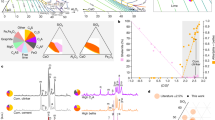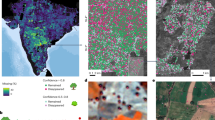Abstract
The agricultural practice of spreading dairy manure on crop fields leads to widespread air and water pollution due to uncontrolled release of greenhouse gases, nutrients and pathogens. The associated environmental impacts can be mitigated by deploying manure processing (MP) systems that capture methane to produce electricity and facilitate nutrient management. Enacted in September 2020, the US Federal Energy Regulatory Commission Order 2222 (FERC-2222) enables distributed energy resource systems to participate in wholesale electricity markets with higher selling prices than historically available to them. Using economic supply chain models, we show that market electricity prices create incentives to deploy MP systems. We highlight the role of FERC-2222 in activating electricity bioeconomies that mitigate environmental impacts resulting from manure spreading. We estimate this bioeconomy to contribute US$131 million in annual revenue for dairy farms and avert US$39 million in greenhouse gas and US$182 million in nutrient emissions within a Wisconsin study area. FERC-2222 incentivizes sustainable dairy manure management and renewable energy production—a dual benefit, demonstrating how effective policy can support sustainable infrastructure.
This is a preview of subscription content, access via your institution
Access options
Access Nature and 54 other Nature Portfolio journals
Get Nature+, our best-value online-access subscription
$29.99 / 30 days
cancel any time
Subscribe to this journal
Receive 12 digital issues and online access to articles
$119.00 per year
only $9.92 per issue
Buy this article
- Purchase on Springer Link
- Instant access to full article PDF
Prices may be subject to local taxes which are calculated during checkout





Similar content being viewed by others
Data availability
All case study data needed to reproduce the results are available on the Zavalab GitHub repository at https://github.com/zavalab/JuliaBox/tree/master/FERC2222Cases. Data are in .csv format.
Code availability
All code needed to reproduce the results is available on the Zavalab GitHub repository at https://github.com/zavalab/JuliaBox/tree/master/FERC2222Cases. Code consists of scripts programmed in the Julia programming language (version 1.6.2) and make use of the JuMP mathematical programming package (0.21). An open-source solver (for example, Clp) will be sufficient to reproduce our results.
References
Aguirre-Villegas, H. A. & Larson, R. A. Evaluating greenhouse gas emissions from dairy manure management practices using survey data and lifecycle tools. J. Clean. Prod. 143, 169–179 (2017).
Chadwick, D. et al. Manure management: implications for greenhouse gas emissions. Anim. Feed Sci. Technol. 166-167, 514–531 (2011).
Sun, B. et al. Agricultural non-point source pollution in China: causes and mitigation measures. Ambio 41, 370–379 (2012).
US EPA. Agriculture nutrient management and fertilizer. https://www.epa.gov/agriculture/agriculture-nutrient-management-and-fertilizer (6 May 2021).
Mueller, D., Wendt, R. & Daniel, T. Phosphorus losses as affected by tillage and manure application. Soil Sci. Soc. Am. J. 48, 901–905 (1984).
Cordell, D. & White, S. Peak phosphorus: clarifying the key issues of a vigorous debate about long-term phosphorus security. Sustainability 3, 2027–2049 (2011).
Cordell, D. & White, S. Sustainable phosphorus measures: strategies and technologies for achieving phosphorus security. Agronomy 3, 86–116 (2013).
Wang, M. et al. The great Atlantic sargassum belt. Science 365, 83–87 (2019).
US EPA. Northern Gulf of Mexico hypoxic zone. https://www.epa.gov/ms-htf/northern-gulf-mexico-hypoxic-zone (10 May 2021).
European Space Agency. Algal bloom in the Baltic sea. https://earth.esa.int/web/earth-watching/environmental-hazards/content/-/article/algal-bloom-in-the-baltic-sea (10 May 2021).
Braunig, W. A. Reflexive law solutions for factory farm pollution. N Y Univ. Law Rev. 80, 1505 (2005).
American Farm Bureau Federation. Farmers for a sustainable future: sustainability facts. https://www.fb.org/land/fsf (14 June 2021).
Clean Lakes Alliance. What we do. https://www.cleanlakesalliance.org/what-we-do/ (27 April 2021).
North American Lake Management Society. Our mission. https://www.nalms.org/our-mission/(10 June 2021).
Healing Our Waters – Great Lakes Coalition. Reducing polluted runoff in the Great Lakes. https://healthylakes.org/lake_issues/reducing-polluted-runoff/(10 June 2021).
Agency, U. E. P. Nutrient pollution: what you can do. https://www.epa.gov/nutrientpollution/what-you-can-do (11 June 2021).
Source Water Collaborative. SWC learning exchange: why everyone should care about nutrient pollution. https://sourcewatercollaborative.org/highlights/swc-learning-exchange-why-everyone-should-care-about-nutrient-pollution/ (11 June 2021).
Recebli, Z., Selimli, S., Ozkaymak, M. & Gonc, O. Biogas production from animal manure. J. Eng. Sci. Technol. 10, 722–729 (2015).
Environmental and Energy Study Institute. Fact sheet ∣ biogas: converting waste to energy. https://www.eesi.org/papers/view/fact-sheet-biogasconverting-waste-to-energy (4 June 2021).
US Federal Energy Regulatory Commission. Order no. 2222: participation of distributed energy resource aggregations in markets operated by regional transmission organizations and independent system operators. https://www.ferc.gov/sites/default/files/2020-09/E-1_0.pdf (2020).
López-Díaz, D. C., Hu, Y., Chan, W., Ponce-Ortega, J. M. & Zavala, V. M. Systems-level analysis of phosphorus flows in the dairy supply chain. ACS Sustain. Chem. Eng. 7, 17074–17087 (2019).
Wilson, J. D., O’Boyle, M. & Lehr, R. Monopsony behavior in the power generation market. Electr. J. 33, 106804 (2020).
Kaufman, J., Roach, A., Moreland, J. & Parcell, J. Biogas Digestion: Economic and Asset Assessment for Missouri Technical Report (2020); https://extension.missouri.edu/media/wysiwyg/Extensiondata/Pro/AgBusinessPolicyExtension/Docs/MO-Biogas-Report.pdf
Krich, K. et al. Biomethane from Dairy Waste: A Sourcebook for the Production and Use of Renewable Natural Gas in California (2005); http://www.suscon.org/pdfs/cowpower/biomethaneSourcebook/Chapter_8.pdf
Wisconsin Biogas Survey Report Technical Report (Wisconsin Office of Energy Innovation, 2011); https://psc.wi.gov/Documents/OEI/WisconsinBiogasSurveyReport.pdf
Radloff, G. The Biogas Opportunity in Wisconsin: 2011 Strategic Plan Technical Report (Univ. Wisconsin-Madison College of Agricultural and Life Sciences, 2011); https://energy.wisc.edu/sites/default/files/Biogas_Opportunity_in_Wisconsin_WEB.pdf
Oregon Dairy Digester Feasibility Study Summary Report Technical Report (EC Oregon, 2010); http://www.oregonrenewables.com/Publications/Reports/OR_DairyBiogasSummaryReport_100125.pdf
US EPA. Agstar data and trends. https://www.epa.gov/agstar/agstar-data-and-trends (3 September 2021).
Appunn, K. Bioenergy - the troubled pillar of the energiewende. Clean Energy Wire (3 September 2021).
Midcontinent Independent System Operator. About miso. https://www.misoenergy.org/about/ (2 July 2021).
Midcontinent Independent System Operator. Real-time pricing report. https://www.misoenergy.org/markets-and-operations/real-time–market-data/market-reports/#nt=%2FMarketReportType%3AReal-Time%2FMarketReportName%3AReal-Time%20Pricing%20Report%20(xls)&t=10&p=0&s=MarketReportPublished&sd=desc (12 July 2021).
Hu, Y. et al. A supply chain framework for the analysis of the recovery of biogas and fatty acids from organic waste. ACS Sustain. Chem. Eng. 6, 6211–6222 (2018).
Biegler, L. T., Grossmann, I. E. & Westerberg, A. W. Systematic Methods for Chemical Process Design (Prentice Hall, 1997).
US EIA. Electricity data browser: net generation, Wisconsin, all sectors, annual 2022. https://www.eia.gov/electricity/data/browser/#/topic/0?agg=2,0,1&fuel=vtvv&geo=00001&sec=g&linechart=ELEC.GEN.WND-WI-99.AELEC.GEN.SUN-WI-99.AELEC.GEN.GEO-WI-99.AELEC.GEN.BIO-WI-99.AELEC.GEN.WWW-WI-99.AELEC.GEN.WAS-WI-99.A&columnchart=ELEC.GEN.ALL-WI-99.A&map=ELEC.GEN.ALL-WI-99.A&freq=A&ctype=linechart<ype=pin&rtype=s&pin=&rse=0&maptype=0 (8 April 2022).
Renew Wisconsin. Bioenergy. https://www.renewwisconsin.org/bioenergy/ (22 March 2021).
Tominac, P. A. & Zavala, V. M. Economic properties of multi-product supply chains. Comput. Chem. Eng. http://www.sciencedirect.com/science/article/pii/S0098135420305810 (2020).
GP Renewables and Trading. Wholesale Power 101: Maximizing Asset Value and Minimizing Risk Presentation https://www.epa.gov/sites/production/files/2016-06/documents/09phillips_final.pdf (28 June 2021).
Federal Energy Regulatory Commission. FERC Order No. 2222: fact sheet. https://www.ferc.gov/media/ferc-order-no-2222-fact-sheet (8 December 2020).
Gharesifard, B., Başar, T. & Domínguez-García, A. D. Price-based coordinated aggregation of networked distributed energy resources. IEEE Trans. Automat. Contr. 61, 2936–2946 (2015).
Federal Energy Regulatory Commission. FERC Order No. 2222-a: order addressing arguments raised on rehearing, setting aside prior order in part, and clarifying prior order in part. https://www.ferc.gov/media/e-1-rm18-9-002 (2021).
Federal Energy Regulatory Commission. FERC Order No. 2222-b: order addressing arguments raised on rehearing, setting aside in part and clarifying in part prior order. https://www.ferc.gov/media/e-4-061721 (2021).
US EIA. Wisconsin electricity profile 2019. https://www.eia.gov/electricity/state/wisconsin/ (28 May 2021).
Acknowledgements
We acknowledge support from the US Department of Agriculture (grant 2017-67003-26055).
Author information
Authors and Affiliations
Contributions
V.M.Z. conceptualized the idea for the paper. E.D.E. and P.A.T. together developed the supply chain model conceptualizations and case studies for this paper. E.D.E. wrote the paper and created the figures, with revision and editing by P.A.T. and V.M.Z. The FERC-2222 supplement is the work of E.D.E. with editing from P.A.T. and V.M.Z.
Corresponding author
Ethics declarations
Competing interests
The authors declare no competing interests, conflicts of interest, or personal ties that would influence or appear to influence the work in this paper.
Peer review
Peer review information
Nature Sustainability thanks Xiaoguang Chen, Bhavik Bakshi, and the other, anonymous, reviewer for their contribution to the peer review of this work.
Additional information
Publisher’s note Springer Nature remains neutral with regard to jurisdictional claims in published maps and institutional affiliations.
Supplementary information
Supplementary Information
Details on FERC policy and additional technical details on formulation.
Rights and permissions
Springer Nature or its licensor (e.g. a society or other partner) holds exclusive rights to this article under a publishing agreement with the author(s) or other rightsholder(s); author self-archiving of the accepted manuscript version of this article is solely governed by the terms of such publishing agreement and applicable law.
About this article
Cite this article
Erickson, E.D., Tominac, P.A. & Zavala, V.M. Biogas production in United States dairy farms incentivized by electricity policy changes. Nat Sustain 6, 438–446 (2023). https://doi.org/10.1038/s41893-022-01038-9
Received:
Accepted:
Published:
Issue Date:
DOI: https://doi.org/10.1038/s41893-022-01038-9



